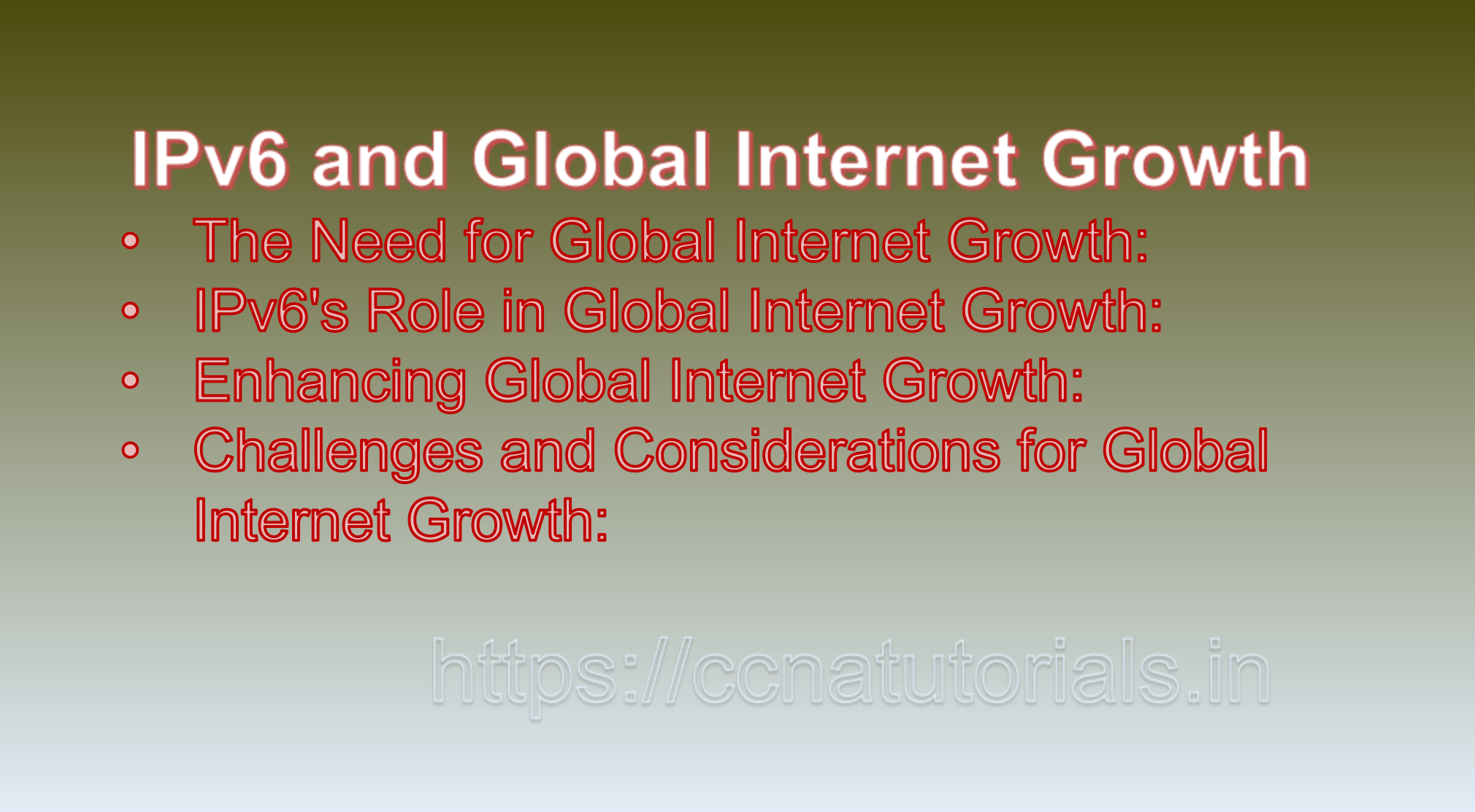Contents of this article
In this article, I describe IPv6 and Global Internet Growth, Enabling Connectivity in a Rapidly Expanding World. The proliferation of internet-connected devices and the increasing demand for online services have strained the capabilities of the traditional Internet Protocol version 4 (IPv4). To accommodate the exponential growth of the internet, Internet Protocol version 6 (IPv6) has emerged as the solution, offering a significantly larger address space and other enhancements. IPv6 plays a pivotal role in facilitating global internet growth by providing the infrastructure required to connect an ever-expanding array of devices, users, and services. This article explores how IPv6 contributes to global internet growth through improved scalability, increased device connectivity, and enhanced innovation.
1. The Need for Global Internet Growth:
The world is undergoing a digital transformation with profound impacts on various aspects of life, including communication, commerce, education, and healthcare. As more regions and populations come online, the demand for internet services continues to surge. Traditional IPv4 addresses are running out, hindering the seamless expansion of the internet to accommodate new users and devices.
2. IPv6’s Role in Global Internet Growth:
IPv6 addresses the limitations of IPv4 and lays the foundation for sustainable global internet growth:
– Larger Address Space: IPv6 introduces a 128-bit address space, providing an astronomical number of unique addresses. This abundance of addresses allows for the connection of countless devices, including smartphones, IoT devices, laptops, and more.
– Scalability: The substantial address space of IPv6 eliminates the need for the intricate Network Address Translation (NAT) mechanisms that IPv4 relies on. This simplifies network architecture and enhances scalability, enabling networks to accommodate more devices and users.
– Efficient Routing: IPv6’s streamlined header structure contributes to efficient routing algorithms, reducing the processing burden on network routers and switches. This efficiency ensures smoother data transmission and lower latency, even in networks with massive traffic volumes.
3. Enhancing Global Internet Growth:
IPv6’s contributions to global internet growth are evident through various aspects:
– IoT Connectivity: The Internet of Things (IoT) thrives on connectivity, enabling everyday objects to exchange data. IPv6’s extensive address space is crucial for the IoT’s proliferation, allowing the connection of an unprecedented number of devices, from smart appliances to industrial sensors.
– Emerging Economies: Developing nations are experiencing rapid internet adoption. IPv6 empowers these regions to embrace internet technologies on a large scale, overcoming IPv4 address shortages that could hinder growth.
– Mobile Connectivity: The mobile revolution has transformed how people access the internet. IPv6 is integral to the growth of mobile networks, supporting the vast number of smartphones, tablets, and wearable devices seeking connectivity.
4. Examples of IPv6 and Global Internet Growth:
– Google’s IPv6 Adoption: Google, a major proponent of IPv6, has actively advocated for its adoption. Google offers its services over IPv6, contributing to the protocol’s growth. The company has witnessed a steady increase in IPv6 traffic, highlighting the impact of IPv6 on global internet expansion.
– APNIC’s IPv6 Initiatives: The Asia-Pacific Network Information Centre (APNIC) has been at the forefront of IPv6 advocacy and education. APNIC’s efforts include providing resources, training, and outreach to promote IPv6 adoption across the Asia-Pacific region, fostering internet growth in diverse economies.
– African Telecommunication Union’s IPv6 Campaign: The African Telecommunication Union (ATU) launched the “One Africa, One IPv6” campaign to accelerate IPv6 adoption on the continent. By promoting awareness and collaboration, ATU aims to ensure that Africa’s internet growth is sustainable and future-ready.
5. Challenges and Considerations for Global Internet Growth:
While IPv6 holds tremendous potential for global internet growth, challenges must be addressed:
– Legacy Systems: Transitioning from IPv4 to IPv6 requires addressing compatibility issues with legacy systems and networks that rely on IPv4. Dual-stack deployment and transition mechanisms can help mitigate this challenge.
– Awareness and Education: Many organizations and individuals are still unaware of IPv6’s importance and benefits. Raising awareness and providing education are crucial to driving adoption.
– Security and Privacy: As the internet grows, security and privacy concerns amplify. IPv6’s design includes security features like IPsec, but organizations must ensure proper configuration and monitoring.

In short IPv6 and Global Internet Growth, Enabling a Connected Future:
IPv6 serves as the backbone of global internet growth, offering the scalability, address space, and efficiency needed to accommodate the ever-expanding digital landscape. As the world becomes more interconnected, IPv6 plays a pivotal role in ensuring that the internet can accommodate new users, devices, and services without compromising performance or innovation. Through advocacy, education, and collaborative efforts, the global community can harness IPv6’s potential to connect the world, foster innovation, and pave the way for a connected future that benefits individuals, societies, and economies across the globe.
IPv6 and Global Internet Growth: Enabling Connectivity in a Growing Digital World
The expansion of the digital landscape and the proliferation of internet-connected devices have highlighted the limitations of the existing Internet Protocol version 4 (IPv4). Internet Protocol version 6 (IPv6) has emerged as a solution to address these limitations and drive global internet growth. This article explores how IPv6 plays a pivotal role in supporting the expanding digital ecosystem, fostering innovation, and ensuring the continued growth of the global internet.
1. IPv6: The Solution for Address Exhaustion:
IPv6 is the next-generation internet protocol designed to replace IPv4, which is running out of available IP addresses due to the exponential growth of internet-connected devices. The IPv6 introduces a 128-bit address space, providing an almost limitless supply of unique addresses. This immense address pool is a fundamental driver of global internet growth.
2. Addressing the Internet of Things (IoT):
The Internet of Things (IoT) encompasses a wide range of devices, from smart appliances to industrial sensors, that are interconnected to exchange data. IPv6’s vast address space is critical for accommodating the sheer volume of IoT devices. Each device can be assigned a unique IPv6 address, enabling seamless communication and data exchange in IoT ecosystems.
3. Examples of IPv6 and Global Internet Growth:
– IoT in Agriculture: In precision agriculture, IoT devices such as soil sensors and weather stations gather data to optimize crop management. IPv6 ensures that these devices can connect and transmit data efficiently, supporting sustainable agricultural practices on a global scale.
– Smart Cities: Urban centers worldwide are implementing smart city initiatives to enhance urban living. IPv6 enables the connectivity of sensors, cameras, and other smart devices, facilitating real-time data collection for traffic management, waste disposal, and public safety.
4. IPv6 and Expanding Mobile Connectivity:
Mobile devices are a significant driver of global internet growth. With the adoption of IPv6, mobile networks can provide unique IP addresses to a multitude of devices, allowing seamless communication and internet access for users worldwide.
5. Examples of IPv6 and Mobile Connectivity:
– 5G Networks: The rollout of 5G networks is expected to significantly enhance mobile connectivity and enable a wide range of applications. IPv6 support is integral to 5G networks, ensuring efficient address allocation for the vast number of devices that will connect to these networks.
– Emerging Markets: In regions with rapidly growing mobile adoption, such as parts of Africa and Asia, IPv6 is essential for providing affordable and accessible internet access to populations that previously lacked connectivity.
6. IPv6 and Cloud Computing:
The cloud computing industry relies on efficient networking to deliver services and data to users across the globe. IPv6’s streamlined routing and vast address space facilitate the growth of cloud services and enable data centers to handle the increasing demand for storage and processing.
7. Examples of IPv6 and Cloud Computing:
– Scalable Infrastructure: Cloud service providers leverage IPv6 to create scalable and flexible infrastructures that can accommodate the dynamic needs of their customers, from small businesses to multinational enterprises.
– Global Accessibility: IPv6’s compatibility with cloud services ensures that users around the world can access applications and data stored in the cloud without encountering addressing conflicts or limitations.
8. IPv6 and Emerging Technologies:
IPv6 is a foundational element for emerging technologies that hold the potential to reshape industries and societies. Innovations like 5G, augmented reality (AR), virtual reality (VR), and blockchain benefit from IPv6’s scalability, efficient routing, and enhanced connectivity.
9. Examples of IPv6 and Emerging Technologies:
– 5G-Powered AR/VR: IPv6’s support for a massive number of connected devices makes it an ideal choice for delivering immersive AR and VR experiences over 5G networks, enabling remote collaboration, entertainment, and training.
– Blockchain and IoT: The combination of IoT devices and blockchain technology can revolutionize supply chain management and asset tracking. IPv6 provides the addressing infrastructure needed to connect and manage a vast network of blockchain-enabled devices.
Conclusion for IPv6 and Global Internet Growth and IPv6’s Role in Shaping the Digital Future
IPv6 is a fundamental enabler of global internet growth. As the world becomes increasingly interconnected and reliant on digital technologies, IPv6’s scalability, streamlined routing, and abundant address space are essential for supporting the expansion of internet-connected devices, services, and applications. From IoT and smart cities to mobile connectivity and emerging technologies, IPv6 plays a pivotal role in shaping the digital landscape and ensuring that the internet remains a catalyst for innovation, economic growth, and improved quality of life on a global scale.






